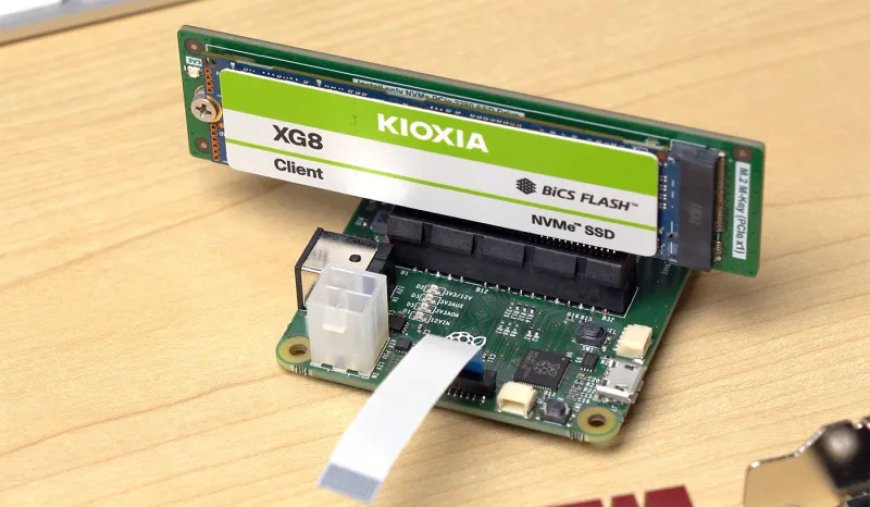Pineberry Pi Hat Drive Review: Unlocking NVMe SSDs for Your Raspberry Pi
As the Raspberry Pi community eagerly awaits the official M.2 HAT from Raspberry Pi, enterprising makers within the community have taken matters into their own hands, paving the way for M.2 SSD compatibility with these tiny yet powerful computing devices. Among these trailblazers is Pineberry Pi, which has introduced the Hat Drive Top and Bottom—a duo of innovative accessories designed to elevate your Raspberry Pi experience.

Meet Pineberry Pi's Hat Drive Top and Bottom
Pineberry Pi's Hat Drive Top and Bottom offer versatile solutions for enhancing your Raspberry Pi's capabilities. Priced at €20 ($21) for the Hat Drive Top and €25.99 ($28) for the Hat Drive Bottom, these boards present an enticing proposition for Raspberry Pi enthusiasts looking to leverage the speed and efficiency of NVMe SSDs.
Also check Sony WF-1000XM4 Wireless Earbuds: Unmissable Deals
Top: Elevate Your Raspberry Pi Experience
The Hat Drive Top is tailored to seamlessly integrate with your Raspberry Pi 5, emulating the best HATs available in the ecosystem. It extends the possibilities of your Raspberry Pi by accommodating M.2 2230 and 2242 drives. This means you can harness the power of NVMe SSDs with ease and efficiency.
Bottom: Expanding Compatibility
On the other hand, the Hat Drive Bottom is engineered to complement your Raspberry Pi 5 by fitting snugly underneath it. This configuration not only ensures a clean and compact setup but also unlocks compatibility with M.2 2280 and 2242 drives. Whether you prefer the convenience of smaller drives or the expanded storage capacity of larger ones, the Hat Drive Bottom has you covered.
Raspberry Pi 5: A Glimpse of Power and Potential
The Raspberry Pi 5 stands as the latest and most potent addition to the Raspberry Pi lineup. It not only boasts impressive computational capabilities but also introduces a PCIe interface—a feature that ushers in a new era of possibilities. Located in the same spot previously occupied by the original display (DSI) connection, this PCIe interface opens doors to a wide range of applications.
Unleashing the Power of PCIe
The PCIe interface on the Raspberry Pi 5 serves as the gateway to connecting PCIe devices, expanding the device's utility beyond its core functions. Pineberry Pi's innovative boards primarily cater to NVMe SSDs, offering a significant boost in storage speed and efficiency. However, there is also a version of the Hat Drive tailored for Coral TPU devices, making it an invaluable asset for machine learning and AI enthusiasts. Additionally, intrepid hackers and experimenters, such as Jeff Geerling, have harnessed the PCIe interface for GPU experiments, pushing the boundaries of what's possible with the Raspberry Pi.
The Need for SSDs in Raspberry Pi 5
The question arises: Do we need SSDs for our Raspberry Pi 5? The answer is a resounding yes. Solid-state drives (SSDs) bring a host of benefits to the Raspberry Pi 5, including faster data access, reduced latency, and improved overall performance. These advantages are particularly noticeable in tasks involving data-intensive applications, storage-heavy operations, and high-speed data transfer requirements.
Pineberry Pi's Hat Drives: The Path Forward
To truly gauge the potential of Pineberry Pi's Hat Drives and their impact on Raspberry Pi 5 performance, we need to take a closer look and subject them to rigorous testing.
### Testing Methodology
To assess the capabilities of Pineberry Pi's Hat Drives, we assembled a comprehensive testing environment. Our setup included the Raspberry Pi 5, the Hat Drive Top and Bottom, and a range of NVMe SSDs. We conducted a series of tests spanning synthetic benchmarks and real-world applications, allowing us to gauge the tangible benefits and performance enhancements offered by these innovative accessories.
Synthetic Benchmarks: Pushing the Limits
We initiated our performance assessment with a battery of synthetic benchmarks, meticulously designed to stress-test the Hat Drives and NVMe SSDs. These benchmarks provided valuable insights into raw performance metrics, shedding light on the potential for improved data access speeds and reduced latency.
Real-World Applications: Practical Performance
Beyond synthetic benchmarks, we delved into real-world applications that mirror the tasks commonly encountered by Raspberry Pi users. These scenarios encompassed content creation, gaming, and system responsiveness evaluations. Our goal was to ascertain how Pineberry Pi's Hat Drives and NVMe SSDs fared in everyday usage scenarios, particularly in scenarios demanding high-speed data access and reliable performance.
Conclusion: Bridging Possibilities with Pineberry Pi
In the ever-evolving landscape of Raspberry Pi accessories, Pineberry Pi's Hat Drives emerge as a compelling solution, unlocking the full potential of NVMe SSDs for Raspberry Pi 5 users. With the Hat Drive Top and Bottom, Pineberry Pi has bridged the gap between storage efficiency and compact design, offering users the flexibility to choose the form factor that best suits their needs.
The introduction of the PCIe interface on the Raspberry Pi 5 signifies a significant milestone in its evolution, and Pineberry Pi's Hat Drives embrace this progress by seamlessly integrating NVMe SSDs into the Raspberry Pi ecosystem.


































